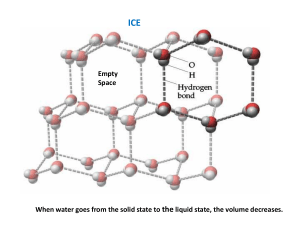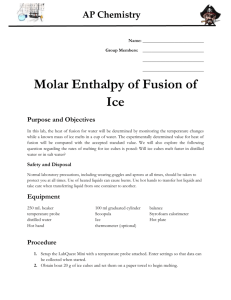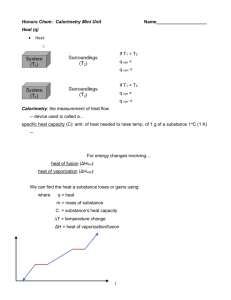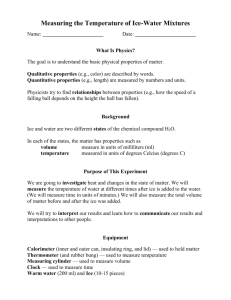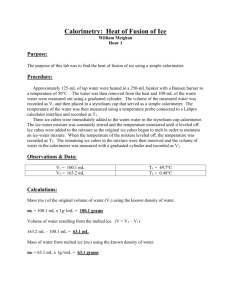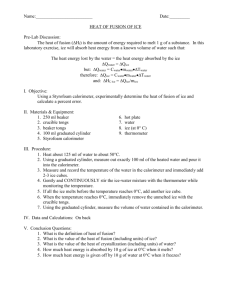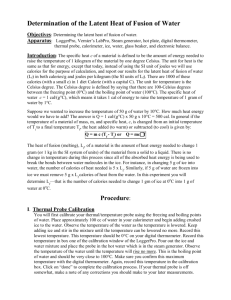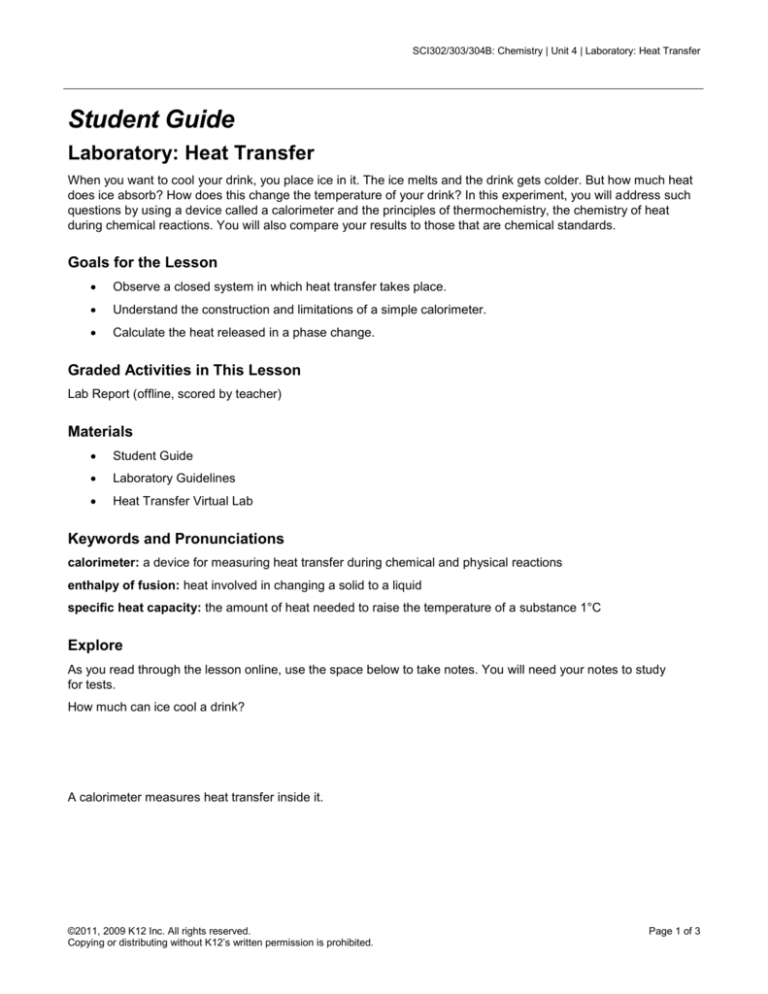
SCI302/303/304B: Chemistry | Unit 4 | Laboratory: Heat Transfer
Student Guide
Laboratory: Heat Transfer
When you want to cool your drink, you place ice in it. The ice melts and the drink gets colder. But how much heat
does ice absorb? How does this change the temperature of your drink? In this experiment, you will address such
questions by using a device called a calorimeter and the principles of thermochemistry, the chemistry of heat
during chemical reactions. You will also compare your results to those that are chemical standards.
Goals for the Lesson
Observe a closed system in which heat transfer takes place.
Understand the construction and limitations of a simple calorimeter.
Calculate the heat released in a phase change.
Graded Activities in This Lesson
Lab Report (offline, scored by teacher)
Materials
Student Guide
Laboratory Guidelines
Heat Transfer Virtual Lab
Keywords and Pronunciations
calorimeter: a device for measuring heat transfer during chemical and physical reactions
enthalpy of fusion: heat involved in changing a solid to a liquid
specific heat capacity: the amount of heat needed to raise the temperature of a substance 1°C
Explore
As you read through the lesson online, use the space below to take notes. You will need your notes to study
for tests.
How much can ice cool a drink?
A calorimeter measures heat transfer inside it.
©2011, 2009 K12 Inc. All rights reserved.
Copying or distributing without K12’s written permission is prohibited.
Page 1 of 3
SCI302/303/304B: Chemistry | Unit 4 | Laboratory: Heat Transfer
How do you calculate heat released?
What is enthalpy of fusion?
Investigate
Safety
Review the Laboratory Guidelines before conducting the lab.
Procedure
1. Open the Heat Transfer Virtual Lab.
2. Click View Tutorial.
3. Complete the tutorial to learn how to conduct the virtual lab.
4. Close the tutorial and click on Begin the Lab.
5. Fill in the table using the virtual lab and the equations provided in the on-screen lesson.
Data and Observations of Heat of Fusion of Water Trials
Observations
Trial 1
Trial 2
Trial 3
Mass of calorimeter 1 (empty; g)
Mass of calorimeter 1 with water (g)
Mass of water (g; calculated)
Beginning temperature of water in
calorimeter 1 (°C)
Final temperature of water in
calorimeter 1 (°C; calculated)
Change in water temperature
(°C; calculated)
Mass of calorimeter 2 (empty; g)
Mass of calorimeter 2 with ice (g)
Mass of ice (g; calculated)
Mass of calorimeter 1 and water
and ice (g)
Mass of ice remaining (g; calculated)
Mass of ice that has melted
(g; calculated)
Heat that is needed to melt the ice
©2011, 2009 K12 Inc. All rights reserved.
Copying or distributing without K12’s written permission is prohibited.
Page 2 of 3
SCI302/303/304B: Chemistry | Unit 4 | Laboratory: Heat Transfer
Observations
Trial 1
Trial 2
Trial 3
(To calculate the number of joules
needed, use the equation q=mCΔT.)
Enthalpy of fusion for each trial (J/g)
(Take the number of joules needed to
melt the ice and divide it by the mass
of the ice that melted.)
6. Do three trials, and calculate enthalpy of fusion for each trial.
7. Use the completed data table to answer the questions in the Lab Report and submit it to your teacher.
©2011, 2009 K12 Inc. All rights reserved.
Copying or distributing without K12’s written permission is prohibited.
Page 3 of 3

